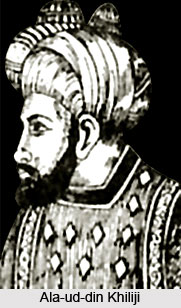 Alauddin Khilji was the first to sack Chittaur on 1303 A.D., overpowered by a passionate desire to possess the regal beauty, queen Padmini. Legend has it, that he saw her face in the reflection of a mirror and was struck by her mesmerizing beauty. But the noble queen preferred death to dishonor and committed `Jauhar`.
Alauddin Khilji was the first to sack Chittaur on 1303 A.D., overpowered by a passionate desire to possess the regal beauty, queen Padmini. Legend has it, that he saw her face in the reflection of a mirror and was struck by her mesmerizing beauty. But the noble queen preferred death to dishonor and committed `Jauhar`.
While his expedition to Chittor the Rajputs inflicted heavy losses on Alauddin`s army. While Alauddin was at Chittor, the Mongals invaded Delhi. Alauddin had to lift the siege of Chittor within a month of commencing it and rush to Delhi to face the Mongals. Turgha Khan headed the Mongals army. The two armies met at Siri, a suburb of Delhi. Alauddin`s army was in a bad shape, as the Rajputs in Chittor had decimated half of his army. The Mongals won but for some reason did not capture Delhi and retreated. A few months later, Alauddin again attacked Chittor . The King of Chittor ,Rana Bhim Singh was captivated on Monday, Aug. 26, 1303 and Chittor fell. Thousands of Rajput women with Rani Padmini inside had entered a cellar and burnt themselves to ashes preferring a fiery death and unsullied honor to the lecherous hell of Islamic torture and venery. Discomfited Alauddin in impotent anger massacred thousands of children and old men found in the fort.
In 1305 Alauddin Khilji captured Malwa and annexed Ujjain, Mandu, Dhar and Chanderi. Alauddin Khilji`s expedition to Bengal was not successful and it remained independent.



















